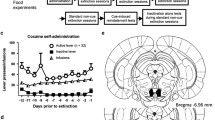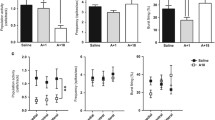Abstract
Separate groups of rats were trained to press a lever on either a fixed-ratio 40 or fixed-interval 1-min schedule of food reinforcement. Amphetamine increased low rates and decreased high rates of responding. In contrast, electrical stimulation of rewarding sites in the ventral tegmentum was effective only in decreasing high response rates. Stimulation of non-rewarding sites had little effect upon either low-or high-rate responding. Another group of rats was trained to discriminate between amphetamine (1.0 mg/kg) and saline in a standard two-lever procedure with food reinforcement. The internal stimulus produced by the stimulation of rewarding sites did not substitute readily for the discriminative stimulus produced by amphetamine.
The results suggest that the operant response-rate decreasing property of amphetamine may be partially mediated through the mesolimbic dopamine system. However, this system may not play a prominent role in mediating either the operant response-rate increasing or discriminable properties of this drug. The idea that the abuse liability of amphetamine may be related to the ability of the drug to interact with one of the central reward systems is discussed.
Similar content being viewed by others
References
Atrens DM, Vietinghoff-Riesch FV, Karabetian AD, Masliyah E (1974) Modulation of reward and aversion processes in rat diencephalon by amphetamine. Am J Physiol 226:874–880
Baldessarini RJ, Kopin IJ (1966) Tritiated norepinephrine: release from brain slices by electrical stimulation. Science 152:1630–1631
Chance WT, Murfin D, Krynock GM, Rosecrans JA (1977) A description of the nicotine stimulus and tests of its generalisation to amphetamine. Psychopharmacology 55:19–26
Colpaert FC (1977) Sensitisation and desensitisation to lateral hypothalamic stimulation. Arch Int Pharmacodyn Ther 230:319–320
Colpaert FC, Kuyps JJMD, Niemegeers CJE, Janssen PAJ (1976) Discriminative stimulus properties of fentanyl and morphine: tolerance and dependence. Pharmacol Biochem Behav 5:401–408
Colpaert FC, Niemegeers CJE, Janssen PAJ (1978) Discriminative stimulus properties of cocaine and d-amphetamine and antagonism by haloperidol: a comparative study. Neuropharmacology 17:937–942
Commissaris RL, Lyness WH, Cordon JJ, Moore KE, Rech RH (1980) The effects of d-lysergic acid diethylamide (LSD), 2,5-dimethoxy-4-methyl-amphetamine (DOM) and d-amphetamine on operant responding in control and 6-hydroxydopamine-treated rats. Pharmacol Biochem Behav 13:621–626
Crow TJ (1972) A map of the rat mesencephalon for electrical self-stimulation. Brain Res 36:265–273
D'Mello GD (1980) Comparison of some behavioural effects of amphetamine and electrical stimulation of the ventral tegmentum. Neurosci Lett Suppl 5:S465
D'Mello GD, Stolerman IP (1977) Comparison of the discriminative stimulus properties of cocaine and amphetamine in rats. Br J Pharmacol 61:415–422
D'Mello GD, Stolerman IP (1978) Methodological issues in drug-discrimination research. In: Colpaert FC, Rosecrans JA (eds) Stimulus properties of drugs: Ten years of progress. Elsevier/North Holland, Amsterdam, pp 243–252
Eddy NB, Halbach H, Isbell H, Seevers MH (1965) Drug dependence: Its significance and characteristics. Bull Wld Hlth Org 32:721–733
Engel J, Carlsson A (1977) Catecholamines and behaviour. In: Essman WB, Valzelli L (eds) Current developments in psychopharmacology. Spectrum Medical and Scientific Books, USA, pp 2–32
Fibiger HC (1978) Drugs and reinforcement mechanisms: a critical review of the catecholamine theory. Ann Rev Pharmacol Toxicol 18:37–56
Fry W, Kelleher RT, Cook L (1960) A mathematical index of performance on fixed-interval schedules of reinforcement. J Exp Anal Behav 3:193–199
Green TK, Harvey JA (1974) Enhancement of amphetamine action after interruption of ascending serotonergic pathways. J Pharmacol Exp Ther 190:109–117
Gunne LM, Anggard E, Jonsson LE (1972) Clinical trials with amphetamine-blocking drugs. Psychiat Neurol Neurochir 75:225–226
Hayes RL, Mayer DJ (1978) Discriminative control of behaviour by electrical stimulation of the brain: a new neuropharmacological strategy. In: Ho BT, Richards III, DW, Chute DL (eds) Drug discrimination and state dependent learning. Academic Press, New York, pp 249–261
Heikkila RE, Orlansky H, Cohen G (1975) Studies on the distinction between uptake inhibition and release of 3H dopamine in rat brain tissue slices. Biochem Pharmacol 24:847–852
Hirschorn ID, Hayes RL, Rosecrans JA (1975) Discriminative control of behaviour by electrical stimulation of the dorsal raphé nucleus: generalisation to lysergic acid diethylamide (LSD). Brain Res 86:134–138
Ho BT, Huang J (1975) Role of dopamine in d-amphetamine-induced discriminative responding. Pharmacol Biochem Behav 3:1085–1092
Holloway JA (1975) Norepinephrine and serotonin: specificity of release with rewarding ICS of brain. Psychopharmacologia 42:127–134
Holtzman SG, Shannon HE, Schaeffer GJ (1977) Discriminative properties of narcotic antagonists. In: Lal H (ed) Discriminative stimulus properties of drugs. Plenum, New York, pp 47–72
Iversen SD (1977) Striatal function and stereotyped behaviour. In: Cools AR, Lohman AHM, VanderBercken JHL (eds) Psychobiology of the striatum, Elsevier/North-Holland, Amsterdam, pp 99–118
Johanson CE (1978) Drugs as reinforcers. In: Blackman DE, Sanger DJ (eds) Contemporary research in behavioural pharmacology. Plenum, New York, pp 325–390
Kant GJ, Meyerhoff JL (1978) Release of norepinephrine and dopamine from rat brain regions in vitro. Life Sci 23:2111–2118
Kuhn DM, Appel JB, Greenberg I (1974) An analysis of some discriminative properties of d-amphetamine. Psychopharmacologia 39:57–66
Lewander T (1977) Effects of amphetamine in animals. In: Martin WR (ed) Drug addiction II: Handbook of experimental pharmacology. Springer, Berlin Heidelberg New York, pp 33–246
Lindvall O, Bjorkland A (1974) The organisation of the ascending catecholamine neuron system in the rat brain as revealed by the glyoxylic acid fluorescence method. Acta Physiol Scand Suppl 412:1–48
Lyon M, Robbins TW (1975) The action of central nervous system stimulant drugs: A general theory concerning amphetamine effects. In: Essman WB, Valzelli L (eds) Spectrum Medical and Scientific Books 2, USA, pp 80–163
Olds ME, Milner P (1954) Positive reinforcement produced by electrical stimulation of the septal area and other regions of the rat brain. J Comp Physiol Psychol 47:419–427
Olds ME, Olds J (1962) Approach-escape interactions in the rat brain. Am J Physiol 203:803–810
Overton DA (1978) Influence of training compartment design on performance in the two-bar drug discrimination task: a methodological report. In: Colpaert FC, Rosecrans JA (eds) Stimulus properties of drugs: ten years of progress. Elsevier/North Holland, Amsterdam, pp 265–278
Overton DA, Batta SK (1977) Relationship between abuse liability of drugs and their degree of discriminability in the rat. In: Thompson T, Unna K (eds) Predicting dependence liability of stimulant and depressant drugs. University Park Press, Baltimore, pp 125–135
Palkovits M, Jacobwitz DM (1974) Topographical atlas of catecholamine and acetylcholinesterase-containing neurones in the rat brain. II. Hindbrain (mesencephalon, rhombencephalon). J Comp Neurol 157:29–42
Pellegrino LJ, Cushman AJ (1967) A stereotaxic atlas of the rat brain. Appleton-Century Crofts. New York
Prado-Alcalá R, Kent EW, Reid LD (1975) Intracranial self-stimulation effects along the route of the nigro striatal bundle. Brain Res 84:531–540
Raiteri M, Bertollini A, Angelini F, Levi G (1975) d-Amphetamine as a releaser or reuptake inhibitor of biogenic amines in synaptosomes. Eur J Pharmacol 34:189–195
Roberts DCS, Corcoran ME, Fibiger HC (1977) On the role of ascending catecholaminergic systems in intravenous self-administration of cocaine. Pharmacol Biochem Behav 6:615–620
Saldate MC, Orrego F (1977) Electrically-induced release of (3H) dopamine from slices obtained from different rat brain cortex regions. Evidence for a widespread dopaminergic innervation of the neocortex. Brain Res 130:483–494
Schecter MD, Cook PG (1975) Dopaminergic mediation of the interoceptive cue produced by d-amphetamine in rats. Psychopharmacology 42:185–193
Schoenfield RI, Zigmond MJ (1973) Behavioural pharmacology of 6-hydroxydopamine. In: Usdin E, Snyder SH (eds) Frontiers in catecholamine research. Pergamon Press, New York, pp 695–700
Seiden LD, Dykstra LA (1977) Psychopharmacology a biochemical and behavioural approach. Van Nostrand Reinhold, New York, pp 283–337
Shannon HE, Holtzman SG (1976) Evaluation of the discriminative effects of morphine in the rat. J Pharmacol Exp Ther 198:54–65
Silverman PB, Ho BT (1977) Characterisation of discriminative response control by psychomotor stimulants. In: Lal H (ed) Discriminative stimulus properties of drugs. Plenum, New York London, pp 107–119
Sparber SB, Peterson DW (1973) Operant behavioural demonstration of qualitative differences between the d-and l-isomers of amphetamine. In: Usdin E, Snyder S (eds) Frontiers in catecholamine research. Pergamon Press, New York, pp 969–972
Stein L (1964) Amphetamine and neural reward mechanisms. In: Steinberg H, de Reuck AVS, Knight J (eds) Ciba foundation symposium/committee for symposia on drug action on animal behaviour. Churchill, London, pp 91–113
Stein L, Wise CD (1969) Release of nordrenaline from hypothalamus and amygdala by rewarding MFB ICS and amphetamine. J Comp Physiol Psychol 67:189–198
Steiner SS, Beer B, Shaffer MM (1969) Escape from self-produced rates of brain stimulation. Science 163:90–91
Stolerman IP, D'Mello GD (1981) Role of training conditions in discrimination of central nervous system stimulants by rats. Psychopharmacology 73:295–303
Stutz RM, Maroli AN (1978) Central mechanisms of reward and the narcotic cue. In: Colpaert FC, Rosecrans JA (eds) Stimulus properties of drugs: ten years of progress. Elsevier/North Holland, Amsterdam, pp 517–534
Stutz RM, Rossi RR, Bowring AM (1971) Competition between food and rewarding brainshock. Physiol Behav 7:953–957
Warburton DM (1975) Biochemical bases of drug dependence. In: Warburton DC (ed) Introduction to the neurochemistry of behaviour. Wiley, London, pp 136–158
Winer BJ (1971) Statistical principles in experimental design. 2nd ed. McGraw-Hill, London
Winter JC (1978) Drug-induced stimulus control. In: Blackman DE, Sanger DJ (eds) Contemporary research in behavioural pharmacology. Plenum, New York, pp 209–237
Wise RA (1978a) Neuroleptic attenuation of intracranial self-stimulation: reward or performance deficits. Life Sci 22:535–542
Wise RA (1978b) Catecholamine theories of reward: a critical review. Brain Res 152:215–247
Zimmerberg B, Glick SD (1974) Rotation and stereotypy during electrical stimulation of the caudate nucleus. Res Commun Chem Pathol Pharmacol 8:195–196
Author information
Authors and Affiliations
Rights and permissions
About this article
Cite this article
D'Mello, G.D. A comparison of some behavioural effects of amphetamine and electrical brain stimulation of the mesolimbic dopamine system in rats. Psychopharmacology 75, 184–192 (1981). https://doi.org/10.1007/BF00432185
Received:
Accepted:
Issue Date:
DOI: https://doi.org/10.1007/BF00432185




